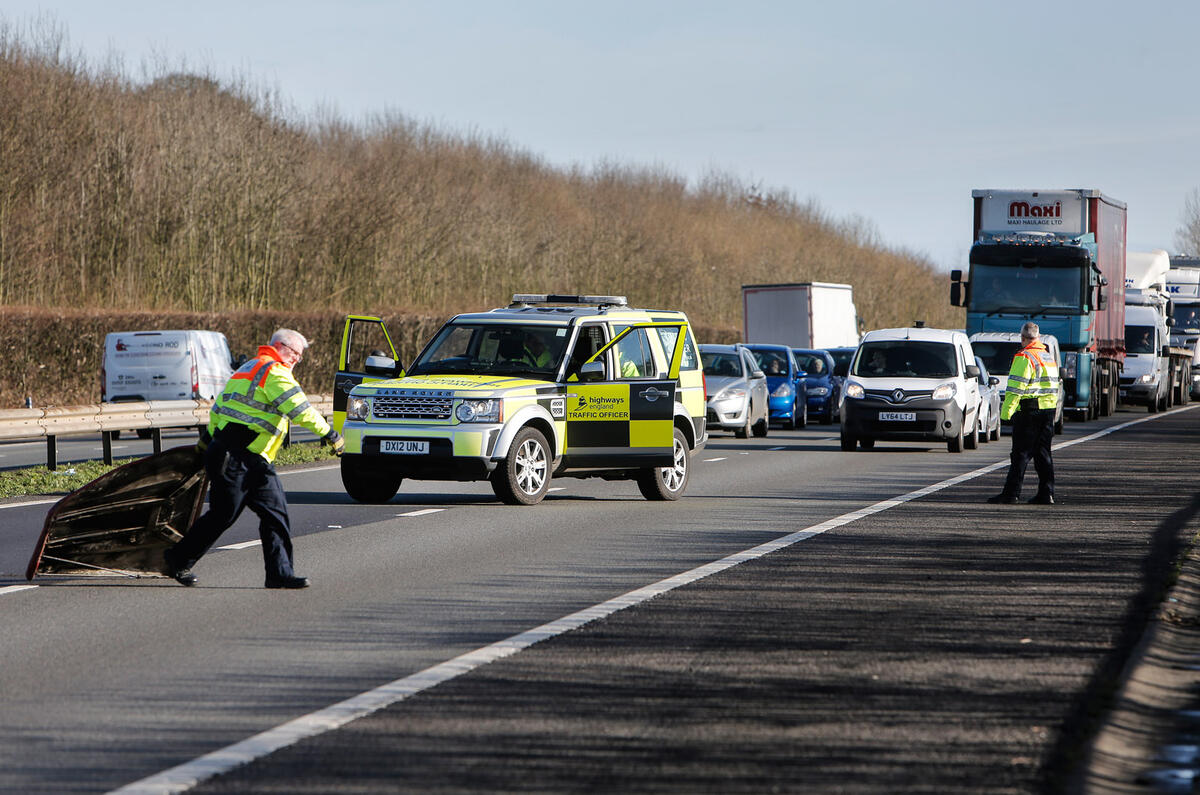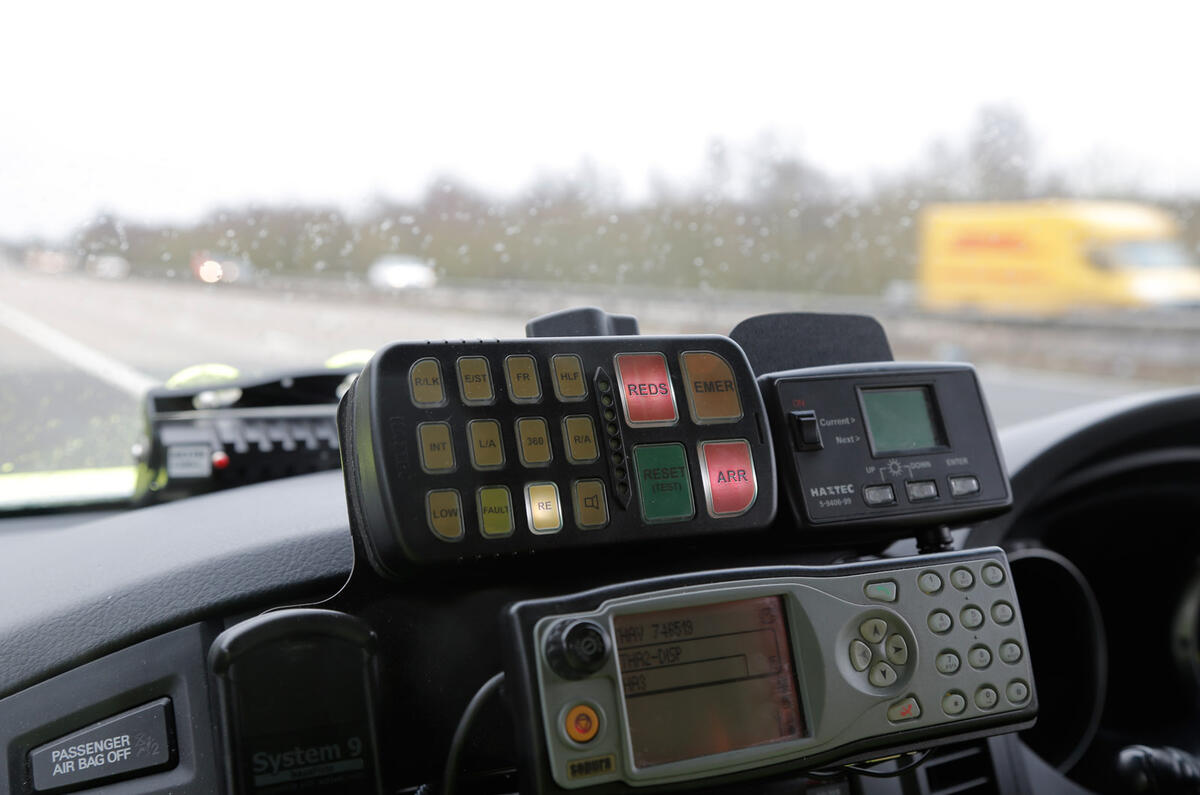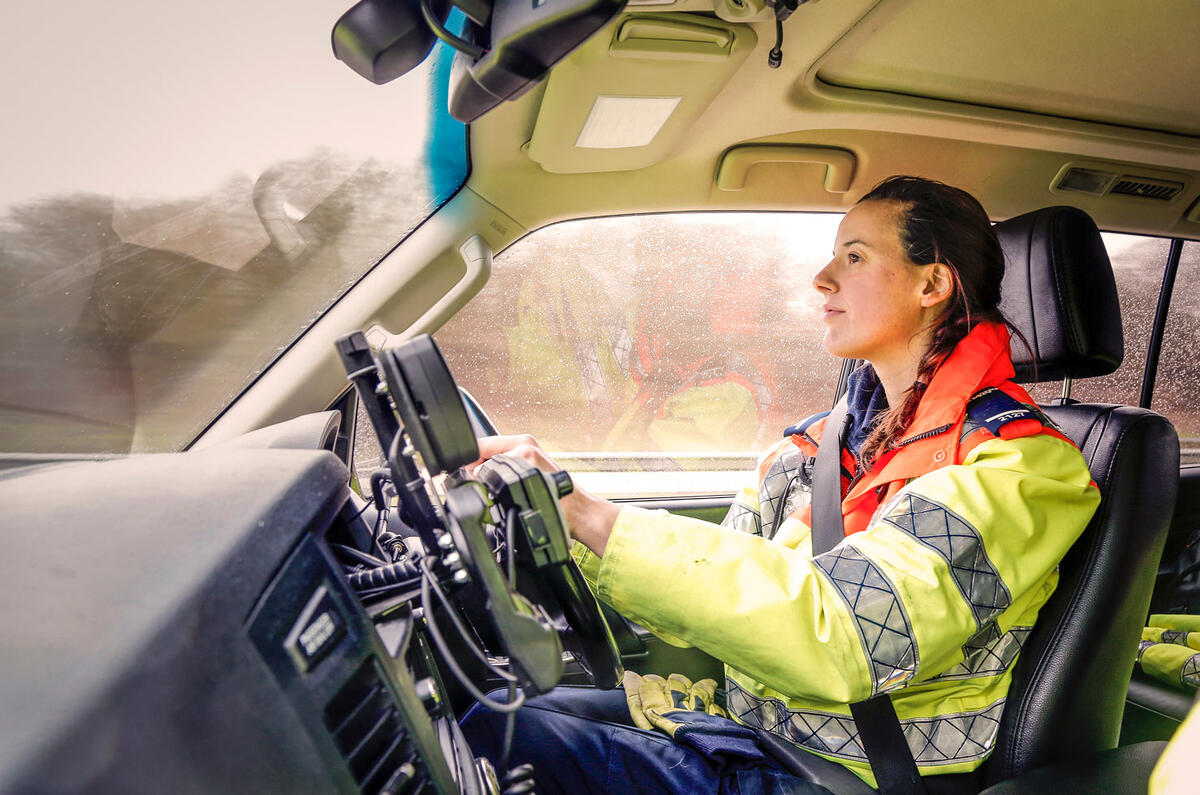King Canute may have had trouble stopping the tide, but not Tony. The Highways England traffic officer (TO) has simply to flick a couple of switches and the tide of cars pounding along the M26 in Kent slows to a crawl and, eventually, to a stop.
Minutes earlier, as we were travelling in the opposite direction, he’d spied the bonnet of a car – the remains of a recent accident – in the central reservation, just inches from the outside lane. There’s a strong wind and Tony reckons that it could blow the bonnet into the road.
So he’s going to move it, and to do that, he must stop the traffic. At the flick of the switch on the Land Rover Discovery’s ‘rolling road’ control panel, the LED message board at the rear of the vehicle displays ‘Slow down’. I turn around in my seat to see the few cars following us fall back. Tony wants to build up a head of traffic so that the lanes behind us become clogged, preventing an impatient driver making a break for it.

Mike, his colleague and our driver, positions the car in the middle of the motorway and, as the abandoned bonnet comes into view, he slows to a crawl before swinging the wheel and pulling up at an angle. Tony flicks the switch marked ‘Stop’.
I look behind again. The two lanes are thick with cars and trucks, all of them at a standstill. Tony jumps out and drags the discarded bonnet to the nearside verge, from where it’ll be retrieved later by a recovery crew.
It’s hard not to feel a twinge of sympathy for the drivers behind us. There you are, late for a business meeting and here, in the words of one popular pundit, is one of those ‘motorway Wombles: a fat bloke with facial hair and a Napoleon complex’, holding you up and ruining your day.





























































Join the debate
Add your comment
Re: 289
There's a reason you haven't seen us tow anyone (or perhaps do anything at all). In a typical shift, I might directly interact with the drivers and passengers of less than 10 vehicles - 10 or so out of literally millions that drive through the area I work in. The work we do is only seen or experienced by a tiny minority of our customers (yes, we use the word customers..), while the remaining millions only see us parked or "standing around". It's one of the biggest frustrations of the job.
There's also a good chance that some of the cars you've seen on the hard shoulder are there because we've put them there, i.e. towed/pushed them clear of the road, where they had broken down or crashed. The hard shoulder is considered a (relatively) safe place, so we generally don't tow vehicles off the hard shoulder.
As for the cars, I imagined me if you thought about it a little, you'd probably find the answer to why we have what we have. The Discos and Shoguns have excellent road presence, are all weather and off road capable, can carry the heavy load that we carry, can tow our trailers, are comfortable to be in for 8 or so hours, are safe for the occupants, and perhaps most importantly, with the the use of the mentioned load cell (which is a little more than just a strong rope, incidentally) can easily clear more or less anything that is blocking the road you wish to drive on - including LGVs, buses and coaches etc.
Besides which, we have tried other vehicles, that all fell short in some respect, including vans, pick ups and estate cars. In the near future we are trialling Outlander PHEVs, and there will no doubt be other vehicle types in future too.
@ coney McConeface
I spend half my life on the motorway, and have NEVER seen one of your vehicles used for anything useful.
I have seen cars stuck in the middle lane of a stationary motorway which I could have quickly towed to the hard shoulder, but the Highway vehicle is parked on the hard shoulder doing nothing with the occupants standing watching with their hands in their pockets!
The hard shoulder is a very UNSAFE place to be, and if you were to serve a useful purpose i would have thought it sensible to tow a broken down car to the next services or refuge if a recovery vehicle isn't available immediately. I have also witnessed your officers standing watching a lone female changing her own wheel, having (of course) blocked off lanes and causing chaos.
Carrying rubber cones around could be achieved in almost any Estate/Van....all would have 'road presence' when covered in your shiny graphics.
You don't need a vehicle capable of going off road on the motorway, and if the weather gets a bit snowy (rarely in this country), you are still going nowhere because the motorway will be logjammed.
Modern vans are perfectly comfortable for 8 hours or more....just speak to any delivery driver, and can carry a larger load than a 4x4.
Its poor use of the tax payers hard earned...end of.
Vans, really?
The police often ask for our help with carriageway clearance precisely because their estate cars aren't as good at it. As said in the article above, we clear debris, facilitate recovery, and clear live lanes. Just because you haven't seen us do it doesn't mean we don't risk our lives every day to ensure you don't get stuck in traffic.
HTO's
I have never seen them tow a vehicle from the hard shoulder ...ever. Mostly they just cause chaos by shutting down lanes and sprinkling cones liberally, whilst standing on the hard shoulder with their hands firmly in their pockets.
They don't even help a lone female change a wheel on their car!
And why the hell they need expensive to buy and run 4x4's when rural police cant get budget for a MUCH NEEDED 4x4....any cheap estate car or even a Van would do the job!!
I actually looked into this
I'd be interested for Autocar to visit one of the control centres who look after the overhead gantries. I have a suspicion the new smart motorways with speed cameras are being used for revenue earning. Fake gantry warnings, or warnings that are left in place for hours after any incident has passed, seems to be the order of the day.